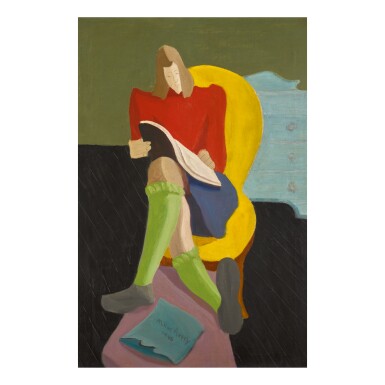American Art
American Art

MILTON AVERY | HOMEWORK
Auction Closed
November 19, 04:22 PM GMT
Estimate
1,500,000 - 2,500,000 USD
Lot Details
Description
MILTON AVERY
1885 - 1965
HOMEWORK
signed Milton Avery and dated 1946 (lower center)
oil on canvas
36 by 24 inches
(91.4 by 61 cm)
The artist
Durand-Ruel Galleries, New York, 1950 (acquired from the above)
M. Knoedler & Co., New York (acquired from the above)
Private collection (sold: Parke-Bernet Galleries, Inc., New York, May 2, 1956, lot 80)
Private collection (acquired at the above sale)
ACA Galleries, New York
Andrew Crispo Gallery, New York
Thyssen-Bornemisza Collection, Madrid, Spain, by 1979 (acquired from the above)
Gift to the present owner from the above, 2002
Emily Genauer, “The Week in Art: Paintings of Daughter,” New York World-Telegram, February 8, 1947, p. 5
Gail Levin, The Thyssen-Bornemisza Collection: Twentieth-century American Painting, London, 1987, no. 96, pp. 288-89, illustrated p. 289
New York, Durand-Ruel Galleries, My Daughter, March by Milton Avery, February-March 1947, no. 11, illustrated n.p.
New York, Andrew Crispo Gallery, 20th Century American Painting and Sculpture, August 1978, no. 23
Perth, Australia, Art Gallery of Western Australia; Adelaide, Australia, Art Gallery of South Australia; Brisbane, Australia, Queensland Art Gallery; Melbourne, Australia, National Gallery of Victoria; Sidney, Australia, Art Gallery of New South Wales, America & Europe, A Century of Modern Masters from the Thyssen-Bornemisza Collection, October 1979-August 1980, no. 78, p. 161, illustrated pp. 96, 161
Wellington, New Zealand, National Art Gallery; Auckland, New Zealand, Auckland City Art Gallery; Christchurch, New Zealand, Robert McDougall Art Gallery, America & Europe, A Century of Modern Masters from the Thyssen-Bornemisza Collection, September-December 1980, no. 78, p. 161, illustrated pp. 96, 161
Vatican City, Rome, Italy, Musei Vaticani; Lugano, Italy, Villa Malpensata, Maestri Americani della Collezione Thyssen-Bornemisza, September 1983-July 1984, no. 87, p. 194, illustrated p. 127 (Rome), no. 85 (Lugano), illustrated n.p.
Baltimore, Maryland, Baltimore Museum of Art; Detroit, Michigan, Detroit Institute of Art; Denver, Colorado, Denver Art Museum; San Antonio, Texas, Marion Koogler McNay Art Institute; New York, IBM Gallery of Arts and Sciences; San Diego, California, San Diego Museum of Art; Palm Beach, Florida, Society of the Four Arts, American Masters: The Thyssen-Bornemisza Collection, 1984-1986, no. 87, p. 166, illustrated p. 113
Kobe, Japan, Hyogo Prefectural Museum of Modern Art; Nagoya, Japan, Nagoya City Art Museum; Tokyo, Japan, Bunkamura Museum of Art; Hiroshima, Japan, Hiroshima City Museum of Contemporary Art, Two Hundred Years of American Painting from the Thyssen-Bornemisza Collection, January 1991-August 1991, n.p.
Chichester, England, Pallant House Gallery, 2016-2019 (on loan)
Milton Avery painted Homework in 1946, by which time he had fully cultivated the brightly colored palette and dramatically simplified formal style that characterizes his mature work. His subject in Homework is his beloved daughter, March, portrayed here at 14 years old. March served as an important source of inspiration for her father after her birth in 1932; images of her served as the unifying theme of his first retrospective at Durand-Ruel Galleries in 1947. Though Avery continued to paint his daughter at all ages throughout his career, his depictions of March as a young teenager are often his most evocative, compellingly capturing the awkwardness of the age with tenderness and intimacy (Fig. 1).
In Homework, Avery portrays March absorbed in her studies, seemingly unaware that her father is sketching her likeness. He emphasizes March’s adolescent gawkiness by exaggerating the length of her legs and positioning them prominently in the center foreground of the composition. Indeed, March’s figure dwarfs the other elements in the picture including the chair in which she sits, conveying a sense that her body is growing and adjusting to its surroundings. Avery’s focus on this transitional age in works like Homework ultimately finds similarities with the preoccupations of many early twentieth-century avant-garde artists such as Pablo Picasso and Balthus, who also explored the mercurial emotional and physical upheavals that distinguish the mercurial years between childhood and adulthood (Fig. 2).
Gail Levin writes of Homework: "Avery treasured his family life and was inspired to paint many pictures of his daughter who was his only child. He actually based his exhibition at the Durand-Ruel Galleries in New York in 1947 on this theme. Other depictions of March extend from the baby in Nursing Mother (1933) to March in Red (1950) (Fig. 3). During the 1940s, Avery produced many figure paintings…His figures appear as generalized, impersonal, abstracted beings. They sometimes become structures for containing his rich, saturated color, often in startling combinations. While Avery did not bother with facial features, in Homework he sketched in March's face, although he made no attempt at modelling. Instead, she is rendered in flat planes with a division line down her center separating the lighter side from the left of the picture which seems to be in shadow. His palette here is particularly intense: her red sweater and blue skirt shown against a bright golden yellow chair. Her knee socks are an acid green while her shoes are a moss green. The background wall is a darker olive green against which is placed the pale blue chest of drawers. She rests her feet on a pink ottoman, upon which rests a turquoise book with the artist's signature. The plank floor boards are black, like a pinstriped suit. The entire floor, together with the olive wall, appears as if it is parallel to the picture plane. Avery achieves this illusion because the lines of the floor boards defy linear perspective" (The Thyssen-Bornemisza Collection: Twentieth-Century American Painting, London, 1987, p. 288).
